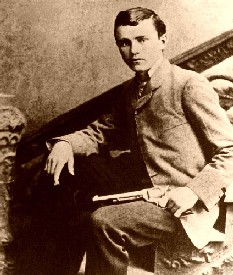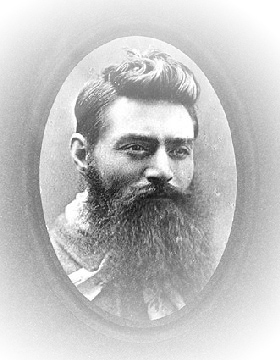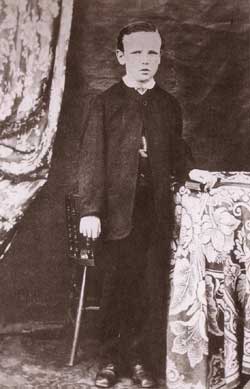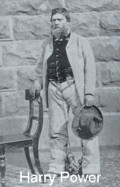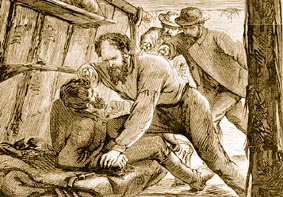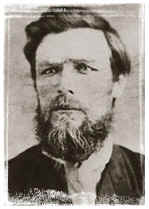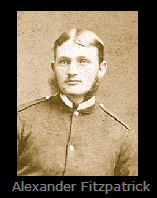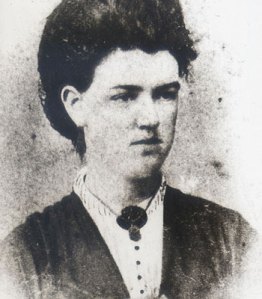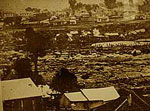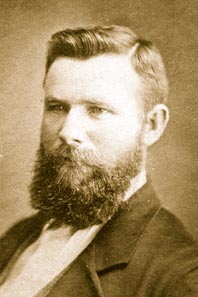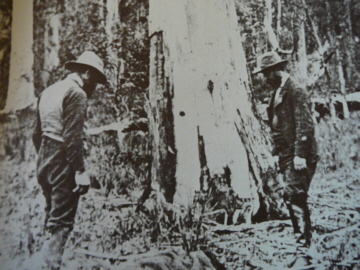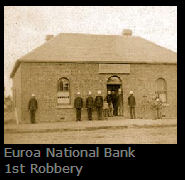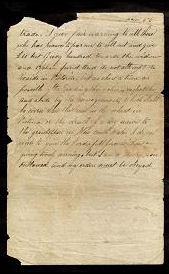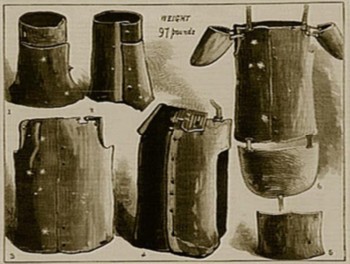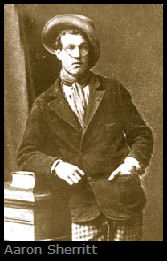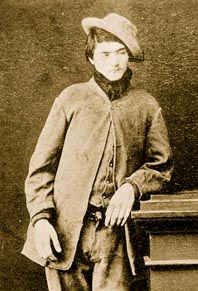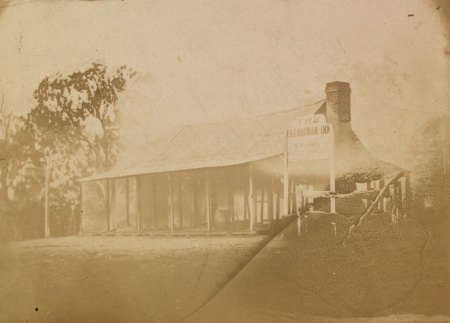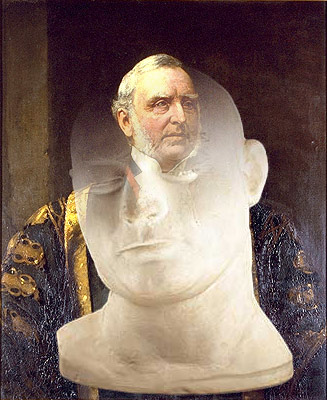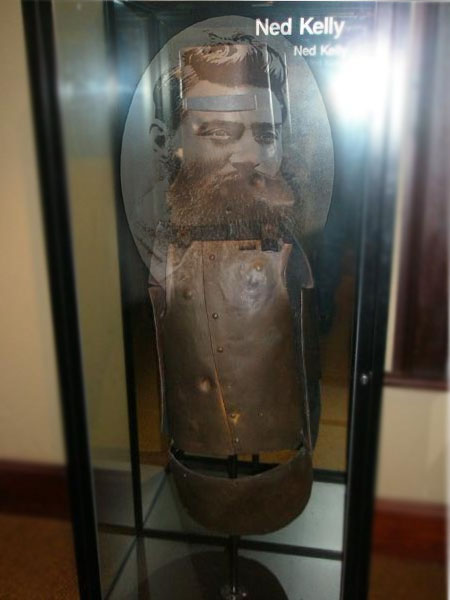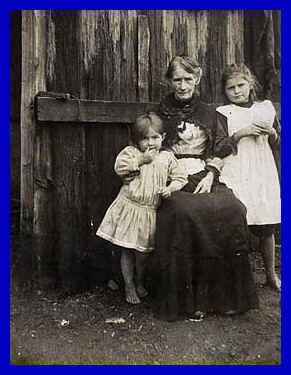Jesse Woodson James was born in Clay County, Missouri, at the site of present day Kearney on 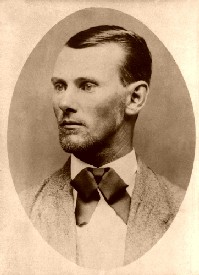 September 5, 1847. His father, Robert S. James, was a commercial hemp farmer and Baptist minister in Kentucky who migrated to Missouri after marriage and helped found Liberty College in Liberty, Missouri. Robert James travelled to California during the Gold Rush and died there when Jesse was three years old.
September 5, 1847. His father, Robert S. James, was a commercial hemp farmer and Baptist minister in Kentucky who migrated to Missouri after marriage and helped found Liberty College in Liberty, Missouri. Robert James travelled to California during the Gold Rush and died there when Jesse was three years old.
After Robert’s death, Jesse’s mother Zerelda remarried, first Benjamin Simms and then a doctor named Reuben Samuel. After their marriage in 1855, Samuel moved into the James home. James had two full siblings: his older brother, Alexander Franklin “Frank” James, and a younger sister, Susan Lavenia James. In addition, Reuben Samuel and Zerelda eventually had four children: Sarah Louisa Samuel (aka Sarah Ellen), John Thomas Samuel, Fannie Quantrell Samuel, and Archie Peyton Samuel.
The approach of the American Civil War overshadowed the James-Samuel household. Missouri was a border state between the North and South, but Clay County lay in a region of Missouri later dubbed “Little Dixie”, where slaveholding and Southern identity were stronger than in other areas. It had been settled chiefly by migrants from the Upper South who brought their cultural practices, including slaveholding, with them. Robert James owned six slaves; after his death, Zerelda and Reuben Samuel acquired a total of seven slaves who raised tobacco on the farm. Clay County became the scene of great turmoil after the passage of the Kansas-Nebraska Act in 1854, when the question of whether slavery would be expanded into the neighboring Kansas Territory dominated public life. Much of the tension that led up to the American Civil War centered on the violence that erupted in nearby Kansas between pro- and anti-slavery militias.
The Civil War
The Civil War ripped Missouri apart, and shaped the life of Jesse James. Guerrilla warfare gripped the state 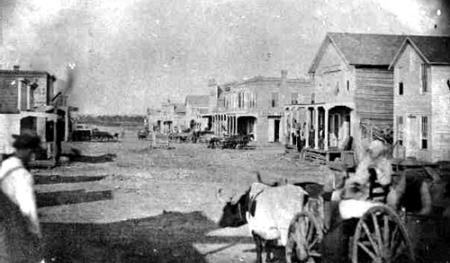 after a series of campaigns and battles between conventional armies in 1861, waged between secessionist “bushwhackers” and Union forces, which largely consisted of local militia organizations. A bitter conflict ensued, bringing an escalating cycle of atrocities by both sides. Guerrillas murdered civilian Unionists, executed prisoners and scalped the dead. Union forces enforced martial law with raids on homes, arrests of civilians, summary executions and banishment of Confederate sympathizers.
after a series of campaigns and battles between conventional armies in 1861, waged between secessionist “bushwhackers” and Union forces, which largely consisted of local militia organizations. A bitter conflict ensued, bringing an escalating cycle of atrocities by both sides. Guerrillas murdered civilian Unionists, executed prisoners and scalped the dead. Union forces enforced martial law with raids on homes, arrests of civilians, summary executions and banishment of Confederate sympathizers.
The James-Samuel family took the Confederate side at the outset of the war. Frank James joined a local company recruited for the secessionist Missouri State Guard, and fought at the battle of Wilson’s Creek, though he fell ill and returned home soon afterward. In 1863, he was identified as a member of a guerrilla squad that operated in Clay County. In May of that year, a Union militia company raided the James-Samuel farm, looking for Frank’s group. They tortured Reuben Samuel by briefly hanging him from a tree and, according to legend, beat young Jesse. Frank escaped. He is believed to have joined the guerrilla organization led by William C. Quantrill, and to have taken part in the notorious massacre of some 200 men and boys in Lawrence, Kansas. Contrary to legend, there is no evidence that Jesse ever rode with Quantrill’s Raiders, as they would later be known.
Frank followed Quantrill to Texas over the winter of 1863–4, and returned in the spring in a squad 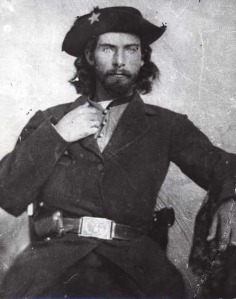 commanded by Fletch Taylor. When they arrived in Clay County, 16-year-old Jesse joined them. In the summer of 1864, Taylor was severely wounded, losing his right arm to a shotgun blast. Frank and Jesse joined the bushwhacker group led by Bloody Bill Anderson. Jesse suffered a serious wound to the chest that summer, but the Clay County provost marshal reported that both Frank and Jesse took part in the Centralia Massacre in September, in which some 22 unarmed Union troops were killed or injured, scalping and dismembering some of the dead. The guerrillas ambushed and defeated a pursuing regiment of Union troops, killing all who tried to surrender. As a result of the James brothers’ activities, their family was exiled from the state of Missouri by the Union military authorities. Anderson was killed in an ambush in October. Frank followed Quantrill into Kentucky; Jesse went to Texas under the command of one of Anderson’s lieutenants, Archie Clement, and returned to Missouri in the spring. Contrary to legend, Jesse James was not shot while trying to surrender, rather, he and Clement were still trying to decide on what course to follow after the Confederate surrender when they ran into a Union cavalry patrol near Lexington, Missouri, and Jesse suffered a life-threatening chest wound.
commanded by Fletch Taylor. When they arrived in Clay County, 16-year-old Jesse joined them. In the summer of 1864, Taylor was severely wounded, losing his right arm to a shotgun blast. Frank and Jesse joined the bushwhacker group led by Bloody Bill Anderson. Jesse suffered a serious wound to the chest that summer, but the Clay County provost marshal reported that both Frank and Jesse took part in the Centralia Massacre in September, in which some 22 unarmed Union troops were killed or injured, scalping and dismembering some of the dead. The guerrillas ambushed and defeated a pursuing regiment of Union troops, killing all who tried to surrender. As a result of the James brothers’ activities, their family was exiled from the state of Missouri by the Union military authorities. Anderson was killed in an ambush in October. Frank followed Quantrill into Kentucky; Jesse went to Texas under the command of one of Anderson’s lieutenants, Archie Clement, and returned to Missouri in the spring. Contrary to legend, Jesse James was not shot while trying to surrender, rather, he and Clement were still trying to decide on what course to follow after the Confederate surrender when they ran into a Union cavalry patrol near Lexington, Missouri, and Jesse suffered a life-threatening chest wound.
The end of the Civil War left Missouri in shambles. The conflict split the population into three bitterly opposed factions: antislavery radical Unionists, who became the Republican Party; the proslavery conservative Unionists, who became the Democratic Party; and the secessionists. The radicals had pushed through a new state constitution that freed Missouri’s slaves but temporarily excluded the former Confederates from voting, serving on juries, becoming corporate officers, or preaching from church pulpits. The atmosphere was volatile, with widespread violence between individuals, armed gangs of radicals, and those bushwhackers who remained under arms.
Jesse, bedridden with his chest wound, was tended to by his first cousin, Zerelda “Zee” Mimms, named after 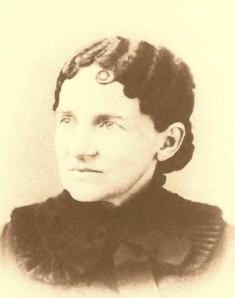 his own mother, who remained in exile in Nebraska until August 1865. Jesse and Zee began a prolonged courtship, leading to their marriage nine years later. Meanwhile, Jesse’s commander, Archie Clement, kept his bushwhacker gang together, and began to harass radical authorities. These men were the likely culprits in the first armed bank robbery in the United States in peacetime, holding up the Clay County Savings Association in the town of Liberty, Missouri, on February 13, 1866. This bank was owned by Republican former militia officers, who had recently conducted the first Republican Party rally in Clay County’s history. One innocent bystander, a student of William Jewell College, was shot dead on the street during the gang’s escape. It remains unclear whether Jesse and Frank James took part; it has been argued that Jesse remained bedridden with his wound, and no concrete evidence has surfaced to connect either brother to the crime. Archie Clement, however, continued his career of crime and harassment of the Republican government, to the extent of occupying the town of Lexington, Missouri, on election day in 1866. The state militia shot Clement dead shortly afterward, an event that Jesse wrote about with bitterness a decade later.
his own mother, who remained in exile in Nebraska until August 1865. Jesse and Zee began a prolonged courtship, leading to their marriage nine years later. Meanwhile, Jesse’s commander, Archie Clement, kept his bushwhacker gang together, and began to harass radical authorities. These men were the likely culprits in the first armed bank robbery in the United States in peacetime, holding up the Clay County Savings Association in the town of Liberty, Missouri, on February 13, 1866. This bank was owned by Republican former militia officers, who had recently conducted the first Republican Party rally in Clay County’s history. One innocent bystander, a student of William Jewell College, was shot dead on the street during the gang’s escape. It remains unclear whether Jesse and Frank James took part; it has been argued that Jesse remained bedridden with his wound, and no concrete evidence has surfaced to connect either brother to the crime. Archie Clement, however, continued his career of crime and harassment of the Republican government, to the extent of occupying the town of Lexington, Missouri, on election day in 1866. The state militia shot Clement dead shortly afterward, an event that Jesse wrote about with bitterness a decade later.
The survivors of Clement’s gang continued to conduct bank robberies over the next two years, though their numbers dwindled through arrests, gunfights, and lynchings. On May 23, 1867, for example, they robbed a bank in Richmond, Missouri in which they killed the town’s mayor and two others. It remains uncertain whether either of the James brothers took part. In 1868, Frank and Jesse James allegedly joined Cole Younger in robbing a bank at Russellville, Kentucky. Jesse James did not become famous, however, until December 1869, when he and (most likely) Frank robbed the Daviess County Savings Association in Gallatin, Missouri. The robbery netted little, but Jesse (it appears) shot and killed the cashier, mistakenly believing the man to be Samuel P. Cox, the militia officer who killed “Bloody Bill” Anderson during the Civil War. James’s self-proclaimed attempt at revenge, and the daring escape he and Frank made through the middle of a posse shortly afterward, put his name in the newspapers for the first time.
The robbery marked Jesse James’s emergence as the most famous of the former guerrillas turned outlaw. It started an alliance with John Newman Edwards, a Kansas City Times editor who was campaigning to return former Confederates to power in Missouri. Edwards published Jesse’s letters and made him into a symbol of Confederate defiance of Reconstruction through his elaborate editorials and favorable reporting. He also reported false information to throw law enforcement off the bandits’ trail. Jesse James’s own role in creating his rising public profile is debated by historians and biographers, though politics certainly surrounded his outlaw career and enhanced his notoriety.
Meanwhile, the James brothers, along with Cole Younger and his brothers John, Jim, and Bob; Clell Miller, and other former Confederates, now constituting the James-Younger Gang, continued a remarkable string of robberies from Iowa to Texas, and from Kansas to West Virginia. They robbed banks, stagecoaches, and a fair in Kansas City, often in front of large crowds, even hamming it up for the bystanders. On July 21, 1873, they turned to train robbery, derailing the Rock Island train in Adair, Iowa and stole approximately $3,000 ($51,000 in 2007). Their later train robberies had a lighter touch—in fact only twice in all of Jesse James’s train hold-ups did he rob passengers, because he typically limited himself to the express safe in the baggage car. Such techniques fostered the Robin Hood image that Edwards was creating in his newspapers.
Pinkertons
The Adams Express Company turned to the Pinkerton National Detective Agency in 1874 to stop the  James-Younger Gang. The Chicago-based agency worked primarily against urban professional criminals, and provided industrial security and broke strikes. The former guerrillas were supported by many former Confederates in Missouri and proved to be too much for them. One agent, Joseph Whicher, was dispatched to infiltrate Zerelda Samuel’s farm and turned up dead shortly afterwards. Two others, Louis J. Lull and John Boyle, were sent after the Youngers; Lull was killed by two of the Youngers in a roadside gunfight on March 17, 1874, though he killed John Younger before he died. A deputy sheriff named Edwin Daniels was also killed in the skirmish.Allan Pinkerton, the agency’s founder and leader, took on the case as a personal vendetta, working with former Unionists who lived near the James’ family farm. He staged a raid on the homestead on the night of January 25, 1875. An incendiary device was thrown inside by the detectives; it exploded, killing James’s young half-brother Archie (named for Archie Clement) and blowing off one of the arms of mother Zerelda Samuel. Afterward, Pinkerton denied that the raid’s intent was arson, though biographer Ted Yeatman located a letter by Pinkerton in the Library of Congress, in which Pinkerton declared his intention to “burn the house down.”
James-Younger Gang. The Chicago-based agency worked primarily against urban professional criminals, and provided industrial security and broke strikes. The former guerrillas were supported by many former Confederates in Missouri and proved to be too much for them. One agent, Joseph Whicher, was dispatched to infiltrate Zerelda Samuel’s farm and turned up dead shortly afterwards. Two others, Louis J. Lull and John Boyle, were sent after the Youngers; Lull was killed by two of the Youngers in a roadside gunfight on March 17, 1874, though he killed John Younger before he died. A deputy sheriff named Edwin Daniels was also killed in the skirmish.Allan Pinkerton, the agency’s founder and leader, took on the case as a personal vendetta, working with former Unionists who lived near the James’ family farm. He staged a raid on the homestead on the night of January 25, 1875. An incendiary device was thrown inside by the detectives; it exploded, killing James’s young half-brother Archie (named for Archie Clement) and blowing off one of the arms of mother Zerelda Samuel. Afterward, Pinkerton denied that the raid’s intent was arson, though biographer Ted Yeatman located a letter by Pinkerton in the Library of Congress, in which Pinkerton declared his intention to “burn the house down.”
The bloody fiasco did more than all of Edwards’s columns to turn Jesse James into a sympathetic figure for much of the public. A bill that lavishly praised the James and Younger brothers and offered them amnesty was only narrowly defeated in the state legislature. Former Confederates, allowed to vote and hold office again, voted a limit on reward offers that the governor could make for fugitives, extending a measure of protection over the James-Younger gang. (Only Frank and Jesse James previously had been singled out for rewards larger than the new limit.)
Jesse and his cousin Zee married on April 24, 1874, and had two children who survived to adulthood: Jesse James, Jr. (b. 1875) and Mary Susan James (b. 1879). Twins Gould and Montgomery James (b. 1878) died in infancy. His surviving son, Jesse, Jr., became a lawyer and spent his career as a respected member of the bar in Kansas City, Missouri.
Jesse James, Jr. (b. 1875) and Mary Susan James (b. 1879). Twins Gould and Montgomery James (b. 1878) died in infancy. His surviving son, Jesse, Jr., became a lawyer and spent his career as a respected member of the bar in Kansas City, Missouri.
On September 7, 1876, the James-Younger gang attempted their most daring raid to date, on the First National Bank of Northfield, Minnesota. Cole and Bob Younger later stated that they selected the bank because of its connection to two Union generals and Republican politicians: Adelbert Ames, the governor of Mississippi during Reconstruction, and Benjamin Butler, Ames’s father-in-law and the Union commander of occupied New Orleans. As it turns out, Ames was a stockholder in the bank, but Butler had no direct connection to it.
The gang divided into two groups. Three men entered the bank, two guarded the door outside, and three remained near a bridge across an adjacent square. The robbers inside the bank were thwarted when acting cashier Joseph Lee Heywood refused to open the safe, falsely claiming that it was secured by a time lock even as they held a bowie knife to his throat and cracked his skull with a pistol butt. Assistant cashier Alonzo Enos Bunker was wounded in the shoulder as he fled out the back door of the bank. Meanwhile, the citizens of Northfield grew suspicious of the men guarding the door and raised the alarm. The five bandits outside fired in the air to clear the streets, which merely drove the townspeople to take cover and fire back from protected positions. Two bandits were shot dead and the rest were wounded in the barrage. Inside, the outlaws turned to flee. As they left, one shot the unarmed Heywood in the head. The identity of the shooter has been the subject of extensive speculation and debate, but remains uncertain.
The gang barely escaped Northfield, leaving their two dead companions behind, along with two innocent victims (Heywood and a Swedish immigrant from the Millersburg community west of Northfield named Nicholas Gustafson). A massive manhunt ensued. The James brothers eventually split from the others and escaped to Missouri. The Youngers and one other bandit, Charlie Pitts, were soon discovered. A brisk gunfight left Pitts dead and the Youngers all prisoners. The James-Younger Gang was destroyed, except for Frank and Jesse James.
In 1876, Jesse and Frank James surfaced in the Nashville, Tennessee area, where they went by the names of Thomas Howard and B. J. Woodson, respectively. Frank seemed to settle down, but Jesse remained restless. He recruited a new gang in 1879 and returned to crime, holding up a train at Glendale, Missouri, on October 8, 1879. The robbery began a spree of crimes, including the hold-up of the federal paymaster of a canal project in Muscle Shoals, Alabama, and two more train robberies. But the new gang did not consist of old, battle-hardened guerrillas; they soon turned against each other or were captured, while James grew paranoid, killing one gang member and frightening away another. The authorities grew suspicious, and by 1881 the brothers were forced to return to Missouri. In December, Jesse rented a house in Saint Joseph, Missouri, not far from where he had been born and raised. Frank, however, decided to move to safer territory, heading east to Virginia.
(Some sources seem to indicate the “Glendale, Missouri” link above is incorrect. The robbery may have occurred in Jackson County, MO. between Independence and Blue Springs near the Little Blue River. The Glendale, Missouri linked above was founded years after the robbery occurred.) Death
With his gang depleted by arrests, deaths, and defections, Jesse James thought that he had only two men left whom he could trust: brothers Robert and Charley Ford. Charley had been out on raids with Jesse before, but Bob was an eager new recruit. To better protect himself, Jesse asked the Ford brothers to move in with him and his family. Little did he know that Bob Ford had been conducting secret negotiations with Thomas T. Crittenden, the Missouri governor, to bring in the famous outlaw. Crittenden had made capture of the James brothers his top priority; in his inaugural address he declared that no political motives could be allowed to keep them from justice. Barred by law from offering a sufficiently large reward, he had turned to the railroad and express corporations to put up a $5,000 bounty for each of them.
On April 3, 1882, after eating breakfast, the Fords and James prepared for departure for another robbery, going in and out of the house to ready the horses. It was an unusually hot day. James removed his coat, then declared that he should remove his fire arms as well, lest he look suspicious. James noticed a dusty picture on the wall and stood on a chair to clean it. Robert Ford took advantage of the opportunity, and shot James in the back of the head.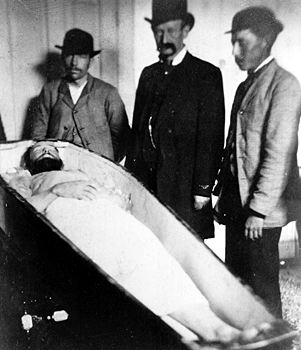
The murder of Jesse James was a national sensation. The Fords made no attempt to hide their role. Indeed, Robert Ford wired the governor to claim his reward. Crowds pressed into the little house in St. Joseph to see the dead bandit, even while the Ford brothers surrendered to the authorities—but they were dismayed to find that they were charged with first degree murder. The Ford brothers were later tried and convicted. They were sentenced to death by hanging, but, two hours later were granted a full pardon by Governor Crittenden.
The governor’s quick pardon suggested that he may have been aware that the brothers intended to kill, rather than capture, Jesse James. (The Ford brothers, like many who knew James, never believed it was practical to try to capture such a dangerous man.) The implication that the chief executive of Missouri conspired to kill a private citizen startled the public and helped to create a new legend around James.
The Fords received a small portion of the reward and fled Missouri. (Some of the bounty went to law enforcement officials who were active in the plan.)
Charley Ford committed suicide on May 6, 1884 in Richmond, Missouri. Bob Ford was killed by a  shotgun blast to the throat in his tent saloon in Creede, Colorado, on June 8, 1892. His killer, Edward Capehart O’Kelley, was sentenced to life in prison. O’Kelley’s sentence was commuted because of a medical condition, and he was released on October 3, 1902.
shotgun blast to the throat in his tent saloon in Creede, Colorado, on June 8, 1892. His killer, Edward Capehart O’Kelley, was sentenced to life in prison. O’Kelley’s sentence was commuted because of a medical condition, and he was released on October 3, 1902.
Zerelda Samuel selected an epitaph for Jesse James that stated: In Loving Memory of my Beloved Son, Murdered by a Traitor and Coward Whose Name is not Worthy to Appear
During his lifetime, Jesse James was celebrated chiefly by former Confederates, to whom he appealed directly in his letters to the press. Indeed, some historians credit his contributing to the rise of Confederates to dominance in Missouri politics (in the 1880s, for example, both U.S. Senators from the state were identified with the Confederate cause). James’ turn to crime after the end of Reconstruction helped cement his place in American memory as a simple but remarkably effective bandit.
During the Populist and Progressive eras, James became a symbol as America’s Robin Hood, standing up against corporations in defense of the small farmer, although his robberies benefited only him and his band. This “heroic outlaw” image is still portrayed in films, as well as songs and folklore. He remains a controversial symbol in the cultural battles over the place of the Civil War in American history. Historians place him among the insurgent guerrillas and vigilantes following the Civil War. The neo-Confederate movement regards him as a hero.
[
The Life After Jesse
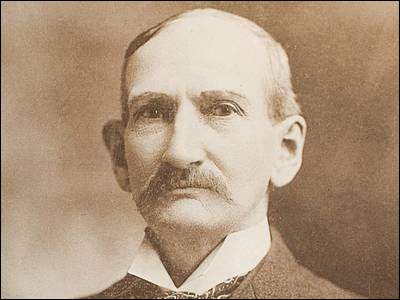 During his years as a bandit, Frank was involved in at least four shootouts between 1868 and 1876, resulting in the deaths of four bank employees or citizens. The most famous incident was the disastrous Northfield, Minnesota raid on September 7, 1876, that ended with the death or capture of most of the gang.
During his years as a bandit, Frank was involved in at least four shootouts between 1868 and 1876, resulting in the deaths of four bank employees or citizens. The most famous incident was the disastrous Northfield, Minnesota raid on September 7, 1876, that ended with the death or capture of most of the gang.Aaron Mittenthal, the future grandparent of composer Aaron Copland, who would go on to romanticize the life of the contemporary outlaw Billy the Kid in his 1938 ballet, hired Frank James to work at a Dallas wholesale and retail dry-goods store. It was James’s running off with the store’s profits that convinced the Mittenthals to leave Texas and return to New York City.
Five months after the murder of his brother Jesse in 1882, Frank boarded a train to Jefferson City, Missouri, where he had an appointment with the governor in the state capitol. Placing his holster in Governor Crittenden’s hands, he explained,
- “I have been hunted for twenty-one years, have literally lived in the saddle, have never known a day of perfect peace. It was one long, anxious, inexorable, eternal vigil.” He then ended his statement by saying, “Governor, I haven’t let another man touch my gun since 1861.”
Accounts say that Frank surrendered with the understanding that he would not be extradited to Northfield, Minnesota
Frank was tried for only two of the robberies/murders – one in Gallatin, Missouri for the July 15, 1881 robbery of the Rock Island Line train at Winston, Missouri, in which the train engineer and a passenger were killed, and the other in Huntsville, Alabama for the March 11, 1881 robbery of a United States Army Corps of Engineers payroll at Muscle Shoals, Alabama. Missouri General Joe Shelby testified on James’ behalf in the Missouri trial. The court was overwhelmed as the two old Confederate veterans embraced. No Missouri jury would have sentenced James after that demonstration. He was acquitted in Alabama as well. Afterwards, Missouri accepted legal jurisdiction over him for other charges but they never came to trial. The Missouri political establishment also kept him from being extradited to Minnesota to be tried in connection with the Northfield Raid.
In the last thirty years of his life, James worked a variety of jobs, including as a shoe salesman and then as a theater guard in St. Louis. One of the theater’s spins to attract patrons was their use of the phrase “Come get your ticket punched by the legendary Frank James.” He also served as an AT&T telegraph operator in St. Joseph, Missouri. With his old comrade Cole Younger, James took up the lecture circuit. In 1902, former Missourian Sam Hildreth, a leading thoroughbred horse trainer and owner, hired James as the betting commissioner at the Fair Grounds Race Track in New Orleans.
In his final years, Frank James returned to the James Farm, giving tours for the sum of 25 cents.He died there on February 18, 1915, aged 72 years.
The James-Younger Gang
Jesse James (1847-1882) – The famous outlaw and leader of the James-Younger gang, robbed banks and  trains for sixteen years. On April 3, 1882, Robert (Bob) Ford and his brother Charles called upon Jesse at his home in St. Joseph, Missouri. The brothers had joined the James Gang and while Jesse was laying out his plans for the next holdup, he turned to adjust a picture on the wall. While his back was turned, Bob Ford shot him from behind. James was 34 years-old. Ford was forever after known as “that dirty little coward
trains for sixteen years. On April 3, 1882, Robert (Bob) Ford and his brother Charles called upon Jesse at his home in St. Joseph, Missouri. The brothers had joined the James Gang and while Jesse was laying out his plans for the next holdup, he turned to adjust a picture on the wall. While his back was turned, Bob Ford shot him from behind. James was 34 years-old. Ford was forever after known as “that dirty little coward
Alexander Franklin “Frank” James, aka: “Buck” (1840-1915) — Frank was the brother of Jesse James,  riding with the James-Younger Gang on most of their robberies. Later, when the Youngers were arrested in the Northfield, Minnesota raid, Frank was a member of the James Gang. After Jesse was killed, he surrendered to authorities in 1882. He was tried and acquitted by a sympathetic Missouri jury. The last thirty years of Frank James’ life saw him not as an illustrious outlaw but as a farmer, shoe salesman, race track starter, and directing a Wild West show. Frank died quietly in 1915 and is buried at Hill Park Cemetery in Independence, Missouri
riding with the James-Younger Gang on most of their robberies. Later, when the Youngers were arrested in the Northfield, Minnesota raid, Frank was a member of the James Gang. After Jesse was killed, he surrendered to authorities in 1882. He was tried and acquitted by a sympathetic Missouri jury. The last thirty years of Frank James’ life saw him not as an illustrious outlaw but as a farmer, shoe salesman, race track starter, and directing a Wild West show. Frank died quietly in 1915 and is buried at Hill Park Cemetery in Independence, Missouri
Thomas Coleman (Cole) Younger (1844-1916) – Cole was an outlaw and the leader of the Younger Gang. He 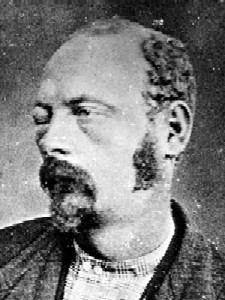 was wounded and captured following the Northfield bank raid on September 7, 1876. After serving more than twenty years in prison, Cole was paroled in 1901 but was not allowed to leave the State of Minnesota. Cole, along with brother Jim sold tombstones and insurance in Minnesota. Cole received an official pardon in 1903 and returned home to Lee’s Summit, Missouri. Cole reunited with Frank James in a touring Wild West show for a time and also went on the lecture circuit preaching the evils of crime. He was known as an elderly churchgoer in his hometown and died quietly in 1916. He is buried in Lee’s Summit, Missouri.
was wounded and captured following the Northfield bank raid on September 7, 1876. After serving more than twenty years in prison, Cole was paroled in 1901 but was not allowed to leave the State of Minnesota. Cole, along with brother Jim sold tombstones and insurance in Minnesota. Cole received an official pardon in 1903 and returned home to Lee’s Summit, Missouri. Cole reunited with Frank James in a touring Wild West show for a time and also went on the lecture circuit preaching the evils of crime. He was known as an elderly churchgoer in his hometown and died quietly in 1916. He is buried in Lee’s Summit, Missouri.
James “Jim” Younger (1848-1902) – Jim, a member of the Younger gang was captured and imprisoned after  the failed Northfield, Minnesota bank raid on September 7, 1876. Jim was paroled in 1901 and fell in love with a newspaper writer, Alice Miller, but was not permitted to marry under the strict parole terms handed down by the state. Despondent, he killed himself on October 19, 1902. His body was returned to his home where is buried in the Lee Summit Historical Cemetery In Lees Summit, Missouri.
the failed Northfield, Minnesota bank raid on September 7, 1876. Jim was paroled in 1901 and fell in love with a newspaper writer, Alice Miller, but was not permitted to marry under the strict parole terms handed down by the state. Despondent, he killed himself on October 19, 1902. His body was returned to his home where is buried in the Lee Summit Historical Cemetery In Lees Summit, Missouri.
 Robert “Bob” Younger – The youngest of the Younger brothers, Bob was severely wounded in the 1876 Northfield raid on September 21, 1876. He was sent to prison, but contracted tuberculosis and died on September 16, 1889. His body was returned to his home where is buried in the Lee Summit Historical Cemetery In Lees Summit, Missouri.
Robert “Bob” Younger – The youngest of the Younger brothers, Bob was severely wounded in the 1876 Northfield raid on September 21, 1876. He was sent to prison, but contracted tuberculosis and died on September 16, 1889. His body was returned to his home where is buried in the Lee Summit Historical Cemetery In Lees Summit, Missouri.
Robert Ford’s letter to Governor Thomas Crittenden
Ford wrote a letter to Governor Thomas Crittenden, telling his version of how he killed Jesse James (April, 1882)
- “On the morning of April 3, Jess and I went downtown, as usual, before breakfast, for the papers. We got to the house about eight o’clock and sat down in the front room. Jess was sitting with his back to me, reading the St. Louis Republican. I picked up the Times, and the first thing I saw in big headlines was the story about Dick Liddil’s surrender. Just then Mrs. James came in and said breakfast was ready. Beside me was a chair with a shawl on it, and as quick as a flash I lifted it and shoved the paper under. Jess couldn’t have seen me, but he got up, walked over to the chair, picked up the shawl and threw it on the bed, and taking the paper, went out to the kitchen. I felt that the jig was up, but I followed and sat down at the table opposite Jess.
- Mrs. James poured out the coffee and then sat down at one end of the table. Jesse spread the paper on the table in front of him and began to look over the headlines. All at once Jess said: “Hello, here. The surrender of Dick Liddil.” And he looked across at me with a glare in his eyes.
- “Young man, I thought you told me you didn’t know that Dick Liddil had surrendered,” he said.
- I told him I didn’t know it.
- “‘Well,” he said, “it’s very strange. He surrendered three weeks ago and you was right there in the neighborhood. It looks fishy.”
- He continued to glare at me, and I got up and went into the front room. In a minute I heard Jess push his chair back and walk to the door. He came in smiling, and said pleasantly: “Well, Bob, it’s all right, anyway.”
- Instantly his real purpose flashed upon my mind. I knew I had not fooled him. He was too sharp for that. He knew at that moment as well as I did that I was there to betray him. But he was not going to kill me in the presence of his wife and children. He walked over to the bed, and deliberately unbuckled his belt, with four revolvers in it, and threw it on the bed. It was the first time in my life I had seen him without that belt on, and I knew that he threw it off to further quiet any suspicions I might have.
- He seemed to want to busy himself with something to make an impression on my mind that he had forgotten the incident at the breakfast table, and said: “That picture is awful dusty.” There wasn’t a speck of dust that I could see on the picture, but he stood a chair beneath it and then got upon it and began to dust the picture on the wall.
- As he stood there, unarmed, with his back to me, it came to me suddenly, ‘Now or never is your chance. If you don’t get him now he’ll get you tonight.’ Without further thought or a moment’s delay I pulled my revolver and leveled it as I sat. He heard the hammer click as I cocked it with my thumb and started to turn as I pulled the trigger. The ball struck him just behind the ear and he fell like a log, dead.”
